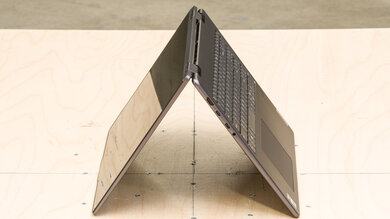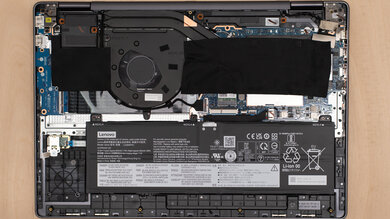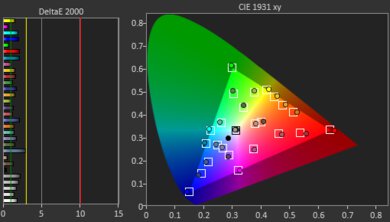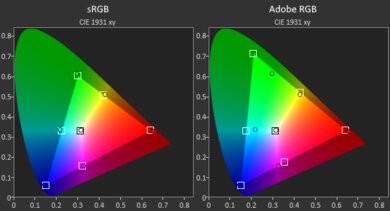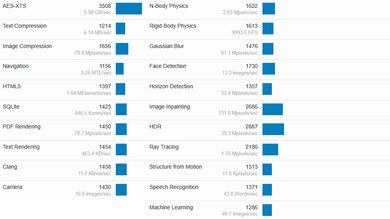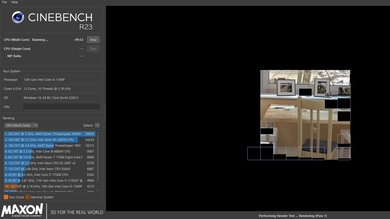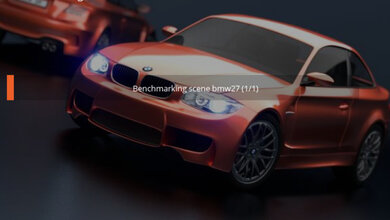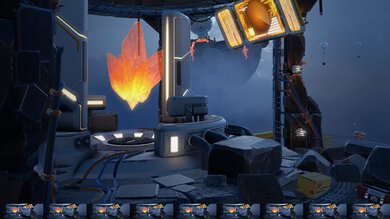The Lenovo Yoga 7i 16 (2023), also known as the Lenovo Yoga 7i 16 Gen 8, is a mid-range 2-in-1 Windows laptop. It replaces the Lenovo Yoga 7i 16 Gen 7 from 2022. Its design is largely the same as its predecessor, although the location of the ports is different. This 2023 model is available with Intel 13th Gen U- and P-series CPUs, up to 16GB of RAM, and up to 1TB of storage. You can choose between a FHD+ (1920 x 1200) or a QHD+ (2560 x 1600) IPS display. It has Wi-Fi 6E wireless connectivity, a 1080p webcam, and a 71Wh battery. Ports include two USB-As, two USB-C/Thunderbolt 4s, an HDMI 1.4, a MicroSD card reader, and a headphone jack.
You can see our unit's specifications and the available configuration options in the Differences Between Variants section.
Our Verdict
The Lenovo Yoga 7i 16 is great for school use. It feels very well-built, and its battery lasts over 12 hours of light use. It has a sharp, bright display, a spacious keyboard, and a large, smooth touchpad. It's available with Intel 13th Gen CPUs, which are fast enough to handle light to moderately intensive workloads; however, its integrated graphics perform poorly, so it isn't ideal for students in fields like 3D graphics and animation. As for portability, it's relatively thin, but it's a 16-inch device nonetheless and on the heavier side.
- Relatively portable for a 16-inch device.
- All-day battery life.
- Large, bright QHD+ display.
- Comfortable keyboard and large touchpad.
- Stylus support.
- Integrated graphics can't handle demanding workloads.
- CPU throttles under load.
The Lenovo Yoga 7i 16 2-in-1 laptop is mediocre for gaming. Although its Intel 13th Gen CPU is capable, its integrated graphics can't handle demanding games. You can play some lighter, puzzle-like titles, but you'll have to play at a lower resolution or with low settings to get smooth gameplay. Also, it has a 60Hz display with a slow response time and doesn't support VRR to reduce screen tearing.
- CPU can handle some demanding workloads.
- Doesn't get hot or loud under load.
- Fast, user-replaceable SSD.
- Integrated graphics can't handle demanding workloads.
- 60Hz display with slow response time.
- Soldered RAM.
- CPU throttles under load.
The Lenovo Yoga 7i 16 is great for media consumption. It's fairly easy to carry around for a 16-inch laptop, and its battery lasts nearly ten hours of video playback. Its QHD+ display looks sharp and gets bright enough to combat glare; however, it isn't the best for dark room viewing, as its low contrast ratio makes blacks appear gray in dim settings. Its factory calibration is outstanding, so you know you're seeing accurate colors. You can also get the laptop with an FHD+ display, although it doesn't look as sharp or bright, and its narrow color gamut makes some colors look slightly washed out. Unfortunately, the speakers don't get very loud and sound unnatural, with almost no bass.
- Relatively portable for a 16-inch device.
- All-day battery life.
- Large, bright QHD+ display.
- Convertible with touch support.
- Blacks look gray in dim settings.
- Quiet speakers sound slightly unnatural with no bass.
The Lenovo Yoga 7i 16 is good for use as a workstation. Its Intel 13th Gen P-series CPUs can handle some demanding tasks; however, they throttle significantly after a few minutes of starting an intensive workload. Additionally, you can only get this laptop with integrated graphics, which aren't powerful enough to handle demanding tasks like video editing or 3D graphics. However, you can do some color work, as its QHD+ display has full sRGB coverage and outstanding factory calibration. It doesn't get hot or loud under load, and its excellent port selection includes two USB-C/Thunderbolt 4 ports and an HDMI.
- CPU can handle some demanding workloads.
- Doesn't get hot or loud under load.
- Fast, user-replaceable SSD.
- Well-calibrated sRGB display for color work.
- Integrated graphics can't handle demanding workloads.
- Soldered RAM.
- CPU throttles under load.
The Lenovo Yoga 7i 16 is great for business use. It feels very well-built and isn't too cumbersome to carry around for a 16-inch device. It has a sharp, bright display, a spacious keyboard, and a large, smooth touchpad. Its excellent port selection includes two Thunderbolt 4s and an HDMI port, making connecting external displays for meetings and presentations easy. It's available with Intel 13th Gen CPUs, which can easily handle general productivity tasks like text processing, spreadsheets, and video playback. Plus, its battery lasts over 12 hours of light use. The webcam's image quality is good, but the microphone sounds staticky.
- Relatively portable for a 16-inch device.
- All-day battery life.
- Large, bright QHD+ display.
- Comfortable keyboard and large touchpad.
- Soldered RAM.
- Staticky microphone.
Changelog
- Updated May 07, 2025: We've updated this review to Test Bench 0.8.3, which removes the viewing angle tests and adds a GPU Total Graphics Power comparison in the GPU section. The Pen Input test in the Extra Features section has also changed, as it now shows whether the laptop supports pen input rather than the inclusion of a stylus in the box. See the changelog for more details.
-
Updated Nov 11, 2024:
Added mention of the Samsung Galaxy Book5 Pro 360 (2024) as an alternative with an OLED display in the Contrast Ratio section.
- Updated Dec 07, 2023: Converted to Test Bench 0.8.2.
- Updated Nov 03, 2023: Converted to Test Bench 0.8.1.
Differences Between Sizes And Variants
We tested the Lenovo Yoga 7i 16 (model 82YN0010US), also known as the Lenovo Yoga 7i Gen 8. Our unit has an Intel Core i5-1340P CPU, Intel Iris Xe integrated graphics, 16GB of RAM, and 512GB of storage. The CPU, memory, and storage are configurable; the available options are in the table below.
| Screen |
|
|---|---|
| CPU |
|
| GPU |
|
| Memory |
|
| Storage |
|
| Color |
|
You can see our unit's label here.
Popular Laptop Comparisons
The Lenovo Yoga 7i 16 is a great productivity laptop and is among the best in its class. It stands out for its sharp, bright display, sturdy build, wide port selection, and long battery life. However, its microphone array isn't as good as the competition because the audio has noticeable static background noise, which can be annoying if you often have online meetings.
For more options, check out our recommendations for the best 2-in-1 laptops, the best Windows laptops, and the best business laptops.
The Lenovo Yoga 7i 16 (2023) and ASUS Zenbook 14 OLED (2024) are quite different products. The Lenovo is a mid-range 16-inch 2-in-1 convertible, while the ASUS is a premium 14-inch ultraportable laptop offering a better user experience overall. To this end, the ASUS features much better build quality, a thinner and lighter design, and a better keyboard and touchpad, making it well-suited for light productivity tasks. By contrast, the Lenovo offers much better battery life and can function like a tablet, which is great for students or professionals who want to annotate notes or documents with a stylus. While the ASUS does have an OLED display that supports touch and pen inputs available, you have to pay extra for this option.
The Lenovo Yoga 7i 16 (2023) and the HP ENVY x360 15 (2023) are both mid-range 2-in-1 convertible laptops. The Lenovo is better for portable use because its battery lasts much longer, and it provides a slightly better user experience with a sharper, brighter display. However, the HP is better for use as a workstation because its CPU doesn't throttle under load, and it's available with an NVIDIA GeForce RTX 3050 discrete GPU. If you need to do color work like photo editing, the HP's display calibration isn't as good as the Lenovo's, but its OLED display has full Adobe RGB and DCI P3 coverage, whereas the Lenovo's QHD+ display only has full sRGB.
The Lenovo IdeaPad Flex 5i 14 (2022) and the Lenovo Yoga 7i 16 (2023) are both 2-in-1 Windows laptops designed for light productivity tasks like web browsing, text processing, and video playback. However, the Yoga 7i is a mid-range model, while the IdeaPad Flex 5i is more of a budget option. The Yoga 7i is better overall; it has a sturdier build, more processing power, and significantly longer battery life. Its larger display gives you more space for split-screen multitasking, and its wider port selection makes it easier to plug in multiple peripherals and external monitors. On the other hand, the IdeaPad Flex 5i could be a better option if media consumption is a priority, as it's available with a nicer 2.8k OLED display.
The Samsung Galaxy Book5 Pro 260 (2024) and the Lenovo Yoga 7i 16 (2023) are both 16-inch 2-in-1 convertibles designed for general productivity. The Samsung is a more premium device that delivers a better user experience overall. It also has more processing power for heavier multitasking, as well as an NPU to handle AI-based tasks like image generation in photo editing apps. That said, the Samsung's OLED display flickers at 120Hz, which might bother people sensitive to flickering, whereas the Lenovo is only available with flicker-free IPS panels.
Test Results

The Lenovo Yoga 7i 16 has a simple, professional look with an all-metal chassis, thin, under-glass bezels, and up-firing speakers. Its rounded edges give it a premium feel and make it comfortable to hold. Instead of an inward notch that cuts into the screen, like the Apple MacBook Air 15 (2023), it has a small protrusion at the top of the display to house the camera and provide a place to hold onto when opening the laptop. The air vents are on the bottom and the back of the device. It's available in two colors: Storm Gray and Arctic Gray.
The Lenovo Yoga 7i 16's build quality is excellent. It has an all-aluminum chassis that feels well-built. It isn't as rigid as a MacBook, like the Apple MacBook Pro 14 (M2, 2023), as there's some flex on the lid, keyboard deck, and display; however, it still feels sturdy, with no obvious gaps in the construction. The finish picks up some fingerprints and smudges but doesn't scratch easily. The device is a tad back-heavy, making it somewhat hard to hold in tablet mode, although that's also because it's a 16-inch device and fairly heavy.
The hinge is good. It feels smooth when opening and closing the lid, and it's very stable, so there's very little wobble. There's a fair amount of resistance, making it all but impossible to open the laptop with one hand; however, that's by design because the hinge needs to be stiff enough to hold the laptop in tent mode.
The Lenovo Yoga 7i 16 is relatively thin, but it's still a 16-inch device and is on the heavier side. Thankfully, the power adapter is compact and lightweight. The laptop comes with a plastic pen holder that plugs into the USB port (not for charging). The pen holder works as intended but feels pretty janky and might break or damage the USB port if you aren't careful.
The Lenovo Yoga 7i 16's serviceability is mediocre. Accessing the internals is relatively easy; you only need to remove seven T5 screws and pry open the bottom panel. It's best to use a pick to do the prying as the seams are pretty tight, and keep the screws organized because they're of different sizes. The storage slot supports M.2 2242 SSDs.
You can see the maintenance manual here.
The Lenovo Yoga 7i 16-inch is available with the following displays:
- 16" IPS 1920 x 1200 60Hz
- 16" IPS 2560 x 1600 60Hz
The QHD+ (2560 x 1600) display looks very sharp and provides plenty of screen real estate for split-screen multitasking. Naturally, the FHD+ (1920 x 1200) isn't as sharp, as it has a lower pixel density of 142 PPI. You can see individual pixels up close at that pixel density, but it isn't a problem at normal viewing distances. Both displays have a 16:10 aspect ratio, which is great for productivity, as the increased vertical space—compared to a 16:9 display—lets you see more information at once when reading a document or website, so you don't have to scroll as much.
The QHD+ display's contrast ratio is good for an IPS panel but still relatively low compared to other display technologies like VA and OLED. This level of contrast makes blacks look gray in dim settings. The FHD+ display likely has the same contrast ratio. Check out the Samsung Galaxy Book5 Pro 360 (2024) if you want a similar laptop with an OLED display.
The display gets bright enough for use in most indoor settings but not outdoors in broad daylight. You might still have trouble with visibility in well-lit rooms because the display's glossy finish doesn't handle direct reflections very well. It gets very dim at the lowest brightness setting, which is great for dark room viewing as it causes less eye strain. The FHD+ display has an advertised brightness of 300 cd/m².
The display's reflection handling is mediocre. Its glossy finish struggles with direct reflections, so it's best to avoid having bright light sources directly behind you, as those reflections are visible, even with the screen at maximum brightness.
The display's out-of-the-box accuracy is outstanding. Most color and white balance inaccuracies are minor and aren't visible to the naked eye. The color temperature is only slightly cooler than the standard 6500K target, resulting in an almost imperceptible blueish tint. As for the gamma, most scenes are a tad too dark, but it does more or less follow the curve.
The QHD+ display has an excellent color gamut. It's an sRGB panel, meaning it only has full coverage of the commonly used sRGB color space. It doesn't have enough coverage of the wider Adobe RGB and DCI P3 color spaces for print photography or HDR video production. The FHD+ display has 45% NTSC coverage, which is about 65% sRGB. It's fine for general productivity and media consumption, but expect some colors to look slightly washed out.
The Lenovo Yoga 7i 16 has a great keyboard. The layout feels spacious and is relatively easy to get used to. Key stability is excellent but imperfect, as some keys wobble more than others. Likewise, the quality of the keycaps is good but not quite as premium-feeling as higher-end laptops. Regarding the typing experience, the keys have a decent amount of travel and don't require much force to actuate. They aren't exactly mushy; however, there's some dampening that gives the keys a softer feel when you bottom out. Typing noise is low, so it won't bother others in quiet environments. You can adjust between two backlight brightness levels or turn it off completely using FN and the spacebar.
The touchpad is good. It's large without being in the way when typing, and it feels very smooth. Tracking works well except around the edges, where it's a little inconsistent, so actions like dragging and dropping over a long distance don't always work properly. There are no issues with gestures and palm rejection. The buttons have a satisfying click, but you can only click in the bottom half of the touchpad. The only other minor complaint is a clacking sound when tapping the touchpad, which can be slightly annoying if you use tap-to-click.
The speakers sound clear but slightly unnatural, with almost no bass whatsoever, so they're better suited for speech-heavy content. There's very little compression at max volume, although they don't get very loud to begin with.
The webcam's video quality is decent. The image has a fair amount of fine detail but is noticeably softer than most 1080p webcams. Also, the tint looks somewhat unnatural, and the colors look slightly washed out. Voices sound loud and clear over the microphone; however, there's some static noise in the background. The privacy cover is only a physical switch, meaning the microphone can still record audio when activated. You can turn off the microphone using the F4 hotkey.
The Lenovo Yoga 7i 16 has an excellent port selection. Both USB-A ports support USB 3.2 Gen 2 data transfer speed; the only difference is that the one closest to the back is always on, meaning you can use it to charge a mobile device even when the laptop is in sleep mode. The two USB-Cs support Thunderbolt 4 (up to 40Gbps data transfer speed and up to two 4k displays at 60Hz), DisplayPort 1.4, and Power Delivery. The latter allows for fast charging of the laptop and other PD-compatible devices connected to the port.
The wireless adapter is an Intel Wi-Fi 6E AX211. Wi-Fi 6E has faster speeds, lower latency, and less signal interference than previous Wi-Fi standards. However, you need a router that supports Wi-Fi 6E to benefit from these features.
The Lenovo Yoga 7i 16 is available with the following CPUs:
- Intel Core i5-1335U (10 cores/12 threads, up to 4.60GHz, 12MB cache)
- Intel Core i7-1355U (10 cores/12 threads, up to 5.00GHz, 12MB cache)
- Intel Core i5-1340P (12 cores/16 threads, 4.60GHz, 12MB cache)
- Intel Core i7-1360P (12 cores/16 threads, up to 5.00GHz, 18MB cache)
All four are processors typically found in thin and light laptops and have a hybrid architecture with a mix of performance and efficiency cores. The Core i5-1335U and i7-1355U have two performance and eight efficiency cores; the only difference is that the i7-1355U has faster clock speeds, giving you slightly better performance. The Core i5-1340P and i7-1360P are more powerful CPUs with four performance and eight efficiency cores, and they run at a higher wattage (typically 28W) than the U-series processors (typically 10W to 15W). The i7-1360P is faster than the i5-1340P, but not significantly.
If you only perform light productivity tasks like text processing, web browsing, and video playback, the U-series CPUs are more than adequate. They're also more power-efficient, so you'll likely get longer battery life. The P-series processors are better suited for more demanding workloads like programming; just know that they'll drain the battery faster. Also, there's likely more thermal throttling on the P-series CPUs, negating some of the performance gains over the U-series processors.
The Lenovo Yoga 7i 16 is only available with Intel Iris Xe graphics. This integrated GPU can only handle light tasks like web browsing and video playback, not demanding workloads like video editing or 3D graphics. You can play some older or puzzle-like games, but you'll likely have to play with low settings for smooth gameplay. The Core i7s have more GPU execution units than the Core i5s; however, the performance difference is very small.
You can configure this laptop with 8GB or 16GB of RAM. The memory isn't user-replaceable.
You can configure this laptop with 256GB, 512GB, or 1TB of storage. The SSD is user-replaceable; the slot only supports M.2 2242 SSDs.
The Lenovo Yoga 7i 16 has an excellent overall score in the Geekbench 5 benchmarks. These scores show that the Intel Core i5-1340P is fast and can easily handle general productivity tasks like text processing, web browsing, and spreadsheets. It can handle more demanding workloads like compiling programs as long as it doesn't stress the CPU more than a couple of minutes at a time, as there's a fair amount of thermal throttling afterward. The Core i5-1335U and i7-1355U are slower because they have fewer cores, while the i7-1360P is slightly faster. As for GPU computing tasks, the integrated GPU performs poorly and isn't suitable for intensive workloads.
The Lenovo Yoga 7i 16 has an outstanding score in the Cinebench R23 benchmarks. The Intel Core i5-1340P can handle 3D rendering and other demanding tasks, but know that it throttles considerably under load, so you aren't getting the full performance of the CPU. If you render 3D images for work, getting a mobile workstation with an H-series CPU and a more effective cooling system is best.
The Lenovo Yoga 7i 16 with an Intel Core i5-1340P CPU performs well in Blender; however, getting a laptop with a discrete GPU is best if you need to render images professionally. Even an entry-level GPU, like an NVIDIA GeForce GTX 1650, can render images much faster than the CPU.
The Lenovo Yoga 7i 16 performs poorly in the Basemark GPU benchmark. Its Intel Iris Xe isn't fast enough to provide smooth gameplay in graphically demanding games. It can only handle simple, puzzle-like games or older titles at 1080p, and even then, you'll have to play at a lower resolution or with low graphics settings to get playable frame rates.
The 512GB SSD's performance is outstanding. Its fast read and write speeds allow the system to quickly boot up, launch apps, and transfer files. It doesn't have the fastest sequential write speed for a PCIe Gen 4 x4 SSD, but it's plenty fast for a general productivity laptop. The 1TB SSD is likely faster, as larger-capacity drives typically perform better.
The Lenovo Yoga 7i 16's battery life is outstanding. You can easily get through a full day of light use or media consumption on a full charge. The two-hour charging time is with the Rapid Charge setting enabled (on by default) in the Lenovo Vantage application. Turning this feature off increases the charge time to 2.9 hours. There's another setting called Overnight Battery Charging, which will allow the battery to charge to 80% and will only resume charging (to 100%) when you start using the laptop. Models with a U-series CPU and/or FHD+ display will likely have longer battery life.
Borderlands 3 isn't playable. The gameplay is extremely choppy, even with low graphical settings. The Intel Iris Xe integrated GPU can't handle such a graphically demanding game. Upgrading to a Core i7 CPU will only improve the frame rate slightly. You can expect the same performance in other similar titles.
Civilization VI is choppy at 1080p with high settings, but you can get much smoother gameplay if you lower a couple of graphical settings. The average turn time is decent and within the expected range for an Intel 13th-Gen P-series processor. Upgrading to the Core i7 will only slightly improve the frame rate and turn time.
Shadow of the Tomb Raider runs poorly at 1080p with high settings. The Intel Iris Xe integrated graphics can't maintain playable frame rates, even with low graphical settings. The Core i7 can push the average frame rate over 30 fps, but you'll still experience frequent stutters due to frame drops.
The keyboard is cool when idle, and the fan is completely silent. The keyboard only gets mildly warm under load, so even though the hot spot is where most people rest their left hand, it isn't uncomfortable by any means. The fan remains relatively quiet at full speed, and the noise isn't bothersome as it's only the sound of heavy airflow. Turning the power setting to Extreme Performance raises the fan noise slightly to 42 dBA.
The Lenovo Yoga 7i 16's performance over time is passable. Though it doesn't get very hot, the CPU has a fair amount of throttling. This is likely to keep the fan noise low and the keyboard from getting uncomfortable. Also, thermal throttling is normal on thin and light laptops. The posted numbers are measurements taken in the Intelligent Cooling mode with Extreme Performance set to 'Auto-Transition'. Performance remains the same with 'Auto-Transition' disabled. Setting the power mode to Extreme Performance results in higher temperatures and slightly more performance loss (26%). Models with a U-series CPU likely throttle less since those processors run at a lower wattage.
The Lenovo Yoga 7i 16 has many pre-installed applications, including:
- Intel Connectivity Performance Suite: Lets you optimize network performance.
- Intel Graphics Command Center: Lets you calibrate the built-in display and apply features like Noise Reduction and Contrast Enhancement.
- Intel Unison: Lets you connect your smartphone to the laptop, allowing you to send and receive messages, view photos on your smartphone, and transfer files, similar to Windows' MyPhone app.
- Lenovo Hotkeys: Lets you create keyboard macros.
- Lenovo Now: Ads for Lenovo Support Services, like Accidental Damage Protection and Smart Lock (remote lock and data wipe). Also contains ads for Amazon Music, Dropbox, Adobe Acrobat, and Lenovo accessories.
- Lenovo Pen Settings: Lets you change the pen's settings.
- Lenovo Smart Appearance: Improves your appearance and applies a background on video calls.
- Lenovo Vantage: Lets you check for drivers/BIOS updates, view system status, change power and audio settings, and view warranty information.
- McAfee LiveSafe: Antivirus and internet security software. Requires subscription.
The Lenovo Yoga 7i 16 has a fingerprint sensor on the keyboard deck below the Numpad and a facial recognition IR camera. You can use either to log in quickly, authorize purchases in the Windows Store, and auto-fill saved passwords on supported websites. Some models include a Lenovo Digital Pen or a Lenovo Precision Pen 2. Both are Wacom AES styluses with 4096 levels of pressure sensitivity and tilt support.
As for the inking experience with the Digital Pen, the latency is noticeable, but it isn't bad enough to make the pen unusable. Palm detection works well, jitter is minimal, and tracking isn't an issue around the edges of the screen. You don't need to recharge the pen; it uses a AAAA battery.



